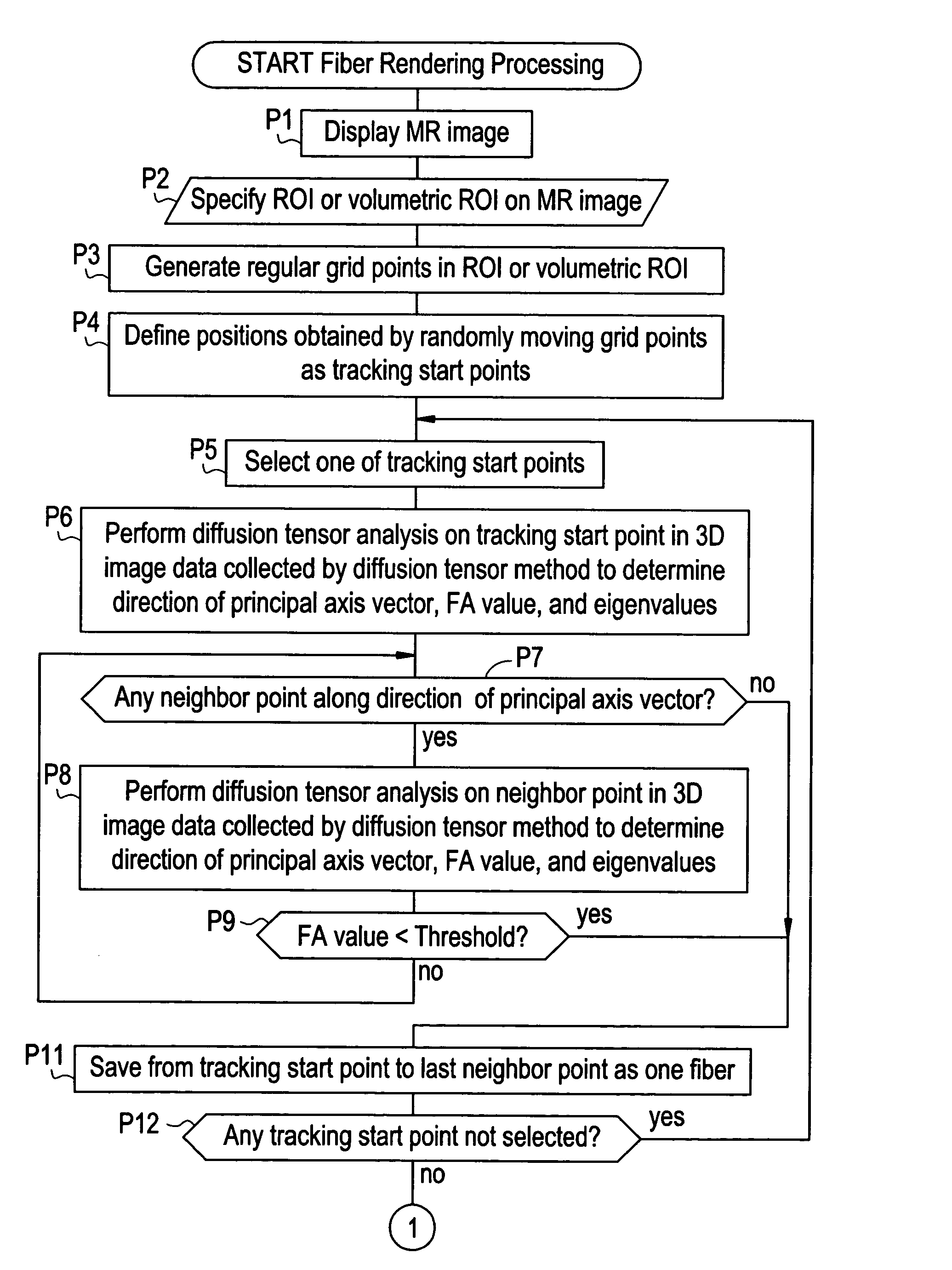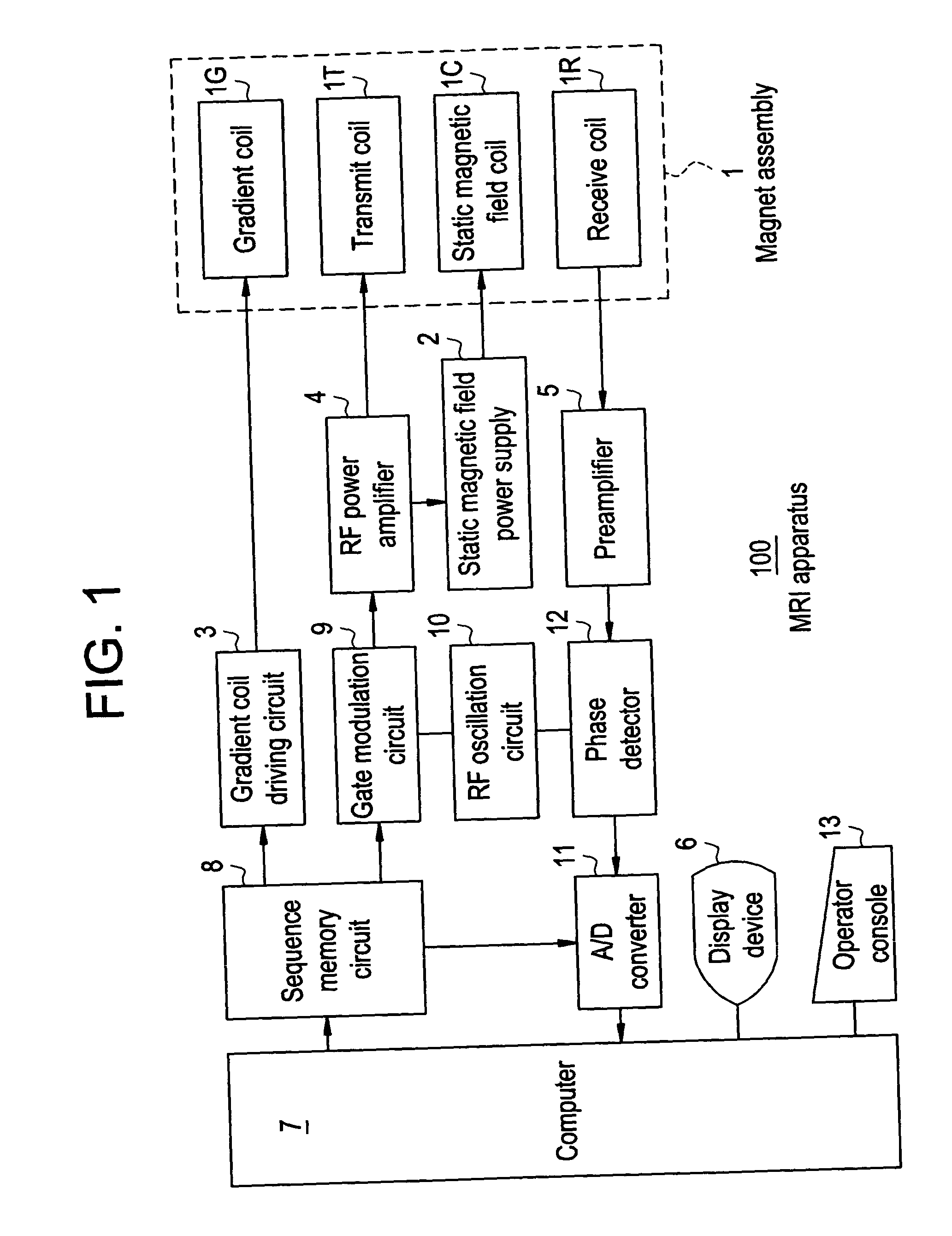Fiber rendering apparatus
a fiber rendering and fiber technology, applied in the field of fiber rendering method and magnetic resonance imaging apparatus, can solve the problems of unnatural image, low fiber tracking reliability, and inability to accurately diagnos
- Summary
- Abstract
- Description
- Claims
- Application Information
AI Technical Summary
Benefits of technology
Problems solved by technology
Method used
Image
Examples
first embodiment
[0103]FIG. 1 is a block diagram showing an MRI apparatus in accordance with one embodiment of the present invention.
[0104] In the MRI apparatus 100, a magnet assembly 1 has a bore (cavity portion) for inserting therein a subject, and is provided, surrounding the bore, with a gradient coil (which comprises X-axis, Y-axis and Z-axis coils, and the combination thereof determines slice, warp and read axes) 1G for generating gradient magnetic fields, a transmit coil 1T for applying RF pulses for exciting spins of atomic nuclei within the subject, a receive coil 1R for detecting NMR signals from the subject, and a static magnetic field power supply 2 and static magnetic field coil 1C for generating a static magnetic field.
[0105] It should be noted that permanent magnets may be employed in place of the static magnetic field power supply 2 and static magnetic field coil 1C (superconductive coil).
[0106] The gradient coil 1G is connected to a gradient coil driving circuit 3. The transmit c...
second embodiment
[0135]FIG. 10 is a flow chart showing fiber rendering processing by an MRI apparatus in accordance with a second embodiment.
[0136] At Step Q1, an MR image in an axial or oblique plane is produced from three-dimensional image data collected by a diffusion tensor method or another imaging method (T1- or T2-enhanced or the like) in the MRI apparatus, and the MR image is displayed.
[0137] At Step Q2, an operator specifies a two-dimensional region of interest R1 (or a three-dimensional volumetric region of interest) on a displayed MR image G1, as shown in FIG. 4.
[0138] At Step Q3, regular grid points g1, g2, g3, . . . are generated in the region of interest R1 (or in the volumetric region of interest), as shown in FIG. 5.
[0139] At Step Q4, points obtained by randomly moving the grid points g1, g2, g3, . . . in a two-dimensional (or three-dimensional) manner are defined as tracking start points S1, S2, S3, . . . , as shown in FIG. 6. Random numbers for the random moving can be generate...
third embodiment
[0158]FIG. 16 is a flow chart showing fiber rendering processing by an MRI apparatus in accordance with a third embodiment.
[0159] At Step Q1, an MR image in an axial or oblique plane is produced from three-dimensional image data collected by a diffusion tensor method or another imaging method (T1- or T2-enhanced or the like) in the MRI apparatus, and the MR image is displayed.
[0160] At Step Q2′, an operator specifies a two-dimensional start region of interest R1 (or a three-dimensional start volumetric region of interest) and a two-dimensional end region of interest R2 (or a three-dimensional end volumetric region of interest) on a displayed MR image G1, as shown in FIG. 19.
[0161] At Step Q3, regular grid points g1, g2, g3, . . . are generated in the start region of interest R1 (or in the start volumetric region of interest), as shown in FIG. 5.
[0162] At Step Q4, points obtained by randomly moving the grid points g1, g2, g3, . . . in a two-dimensional (or three-dimensional) mann...
PUM
 Login to View More
Login to View More Abstract
Description
Claims
Application Information
 Login to View More
Login to View More - R&D
- Intellectual Property
- Life Sciences
- Materials
- Tech Scout
- Unparalleled Data Quality
- Higher Quality Content
- 60% Fewer Hallucinations
Browse by: Latest US Patents, China's latest patents, Technical Efficacy Thesaurus, Application Domain, Technology Topic, Popular Technical Reports.
© 2025 PatSnap. All rights reserved.Legal|Privacy policy|Modern Slavery Act Transparency Statement|Sitemap|About US| Contact US: help@patsnap.com



